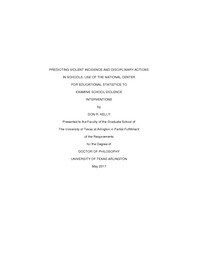| dc.description.abstract | Background: Violence reduction in schools has become an important consideration as school administrators work to provide a safe and peaceful atmosphere for learning. This study provided evidence of main effect and interaction effect utilizing multiple interventions to predict the number of serious violent incidents and total number of disciplinary actions recorded in schools. Additionally, this study aimed to identify interventions demonstrating the greatest promise for changing school culture.
Research indicates that culture change, conflict transformation education, restorative justice/discipline, and mental health interventions are popular processes for reducing violence in schools. It was the intention of the researcher to determine what degree these interventions predict school violence and understand the relationship between culture change, conflict transformation education, restorative justice/discipline, mental health variables, and outcomes. Understanding the relationship between these interventions should identify which interventions were significantly associated with rates of school violence.
Methods: Data from National Center for Educational Statistics (NCES) study, a nationally representative study of US schools (n = 2648), was used to identify use of interventions intended to reduce school violence. Schools reported use of Conflict Transformation Education interventions, Restorative Justice/Discipline interventions, culture change strategies, and mental health services were identified in the dataset. Using Poisson regression modeling, schools’ reported use of these interventions was used to predict rates of serious violent incidents and disciplinary actions recorded, after controlling for school characteristics. Furthermore, an interaction effect was tested between Restorative Justice/Discipline and other intervention types. Schools’ reported use of Conflict Transformation Education interventions, Restorative Justice/Discipline interventions, culture change strategies, and mental health services were hypothesized to predict a lower reports of school violence. Furthermore, it was hypothesized the interaction effect between Restorative Justice/Discipline interventions and each culture change, conflict transformation education, and mental health variables would predict a lower rates of school violence.
Results: The findings generally demonstrated that increased reported use of interventions was associated with greater reported rates of both serious violent incidence and disciplinary action reported. Schools reported levels of serious violent incidence and disciplinary action reported varied by school characteristic, including school level, size, minority population, and urbanicity. However, use of Conflict Transformation Education interventions and Restorative Justice/Discipline interventions were predictive of lower rates of violence reported in schools. This indicated that schools using Conflict Transformation Education and Restorative Justice/Discipline interventions together could experience lower levels of serious violent incidents. Finally, schools which reported using both mental health and restorative justice/discipline together reported lower rates of disciplinary actions reported. Schools implementing either mental health or conflict transformation education coupled with restorative justice/discipline interventions might then report experiencing lower levels of serious violent incidence and disciplinary action reported.
Conclusion: An explanation of the finding, limitations, implications for theory, school social work, and policy are advanced. While more research is needed, this study provides a solid foundation for future studies. Teaching our children how to build a peaceful school environment could provide them with the knowledge for building a future peaceful society. | |


